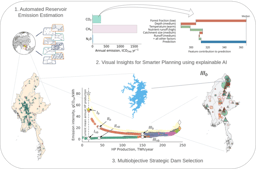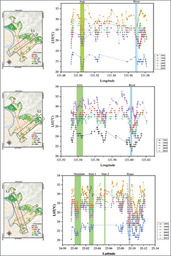Sustainable transition assessments need realistic energy consumer details
Published in Earth & Environment, Sustainability, and Computational Sciences

The current limitation
Transitioning to sustainable, low-carbon energy systems is one of the toughest challenges of our time. Cities now host most of the world’s population, with urban expansion driving up energy consumption due to climate, socioeconomics, and demographics [1]. According to the IPCC AR6, buildings accounted for about 21% of global greenhouse gas emissions in 2019, around 12 Gt CO₂-eq [2]. Yet, these big-picture numbers often focus on buildings as single units, ignoring the actual consumers who shape energy use. People’s energy use is not uniform; it varies with their climate, income, geography, and social context [3][4]. Still, many models treat consumers as one type of agent with the same characteristics, which leads to misleading projections and poor policy outcomes. To steer a realistic and fair energy transition, we need to include the heterogenous, diverse and evolving conditions of actual energy consumers, making bounded decisions under external restrictions.
The gap
Most climate-energy-economic models simplify and homogenise millions of consumers into one “representative” and optimal agent [5][6][7]. This approach assumes that everyone is rational, fully informed, and driven mostly by prices, ignoring key factors such as climate-driven energy demands, income distributions, and demographic shifts. People in colder regions have distinct heating needs, while those in warmer climates have cooling needs. Income levels vary widely and shape access to efficient technologies, regardless their actual needs. By ignoring these differences, models produce inaccurate forecasts and flawed policy advice. We know this is not realistic, yet the practice persists. We need models that reflect how consumers truly live, work, and use energy, realistic assessments. This means representing their heterogeneity, diversity, changes over time, and constrained decision-making under external factors.
The novelty (solution)
This research introduces geospatial artificial intelligence (GeoAI) methods to model energy consumers more accurately. GeoAI merges machine learning with geospatial big data analytics [8] to define and characterise energy consumers globally, according to their income level, their actual needs of energy based on climate realities and their propensity to use energy technologies. By tapping large global datasets, we can capture climate (energy demand changes) [9], demographics (population growth, density) [10], and socioeconomic factors (income, HDI) [10]. This allows us to move beyond simple assumptions and build a realistic view of energy consumers worldwide. When we combine multiple geospatial layers, we can spot patterns and clusters that highlight how conditions vary by location. While the potential of GeoAI is huge, few global frameworks tailor it to define energy consumers. This research addresses that gap.

What makes this study new is its global definition of a range of energy consumers, covering regions often neglected, the Global South. These regions, despite having climate conditions comparable to those in the Global North, may not have the necessary financial resources to invest in more efficient technologies. This is particularly true when basic necessities such as shelter, clean water, sanitation, and education are still not adequately met. We use GeoAI-ML on 1 km² gridded data of climate, socioeconomics, and demographics globally, in the Global North and the Global South, observing a range of energy realities. We define energy consumer agents by heterogeneity (3 geospatial parameters), diversity (8 parameters), and evolution (2 parameters). Instead of seeing consumers as hyper-rational (representative agent seeking optimal solutions), we consider bounded rationality and external constraints, as suggested by Simon [11], Bardazzi and Bosello [12], Karjalainen et al. [13], Shaikh [5], and Farmer and Foley [14], among others [15]. By adding evidence-based parameters from climate, socioeconomics, and geography, we make consumer representation more realistic. This understanding of micro-level energy demand helps better design of macro-level policies.
Results
Figure 1 (top) shows a global geospatial representation of agents obtained by overlaying reclassified GDP per capita (GDPpc) and Heating demand per capita (HDpc). This combination produces twenty-four distinct agents when six GDPpc classes are crossed with four HDpc classes. Agents with lower GDPpc and HDpc appear in regions such as OCSA, OAFR, CHN, and ODA, while higher GDPpc-HDpc agents are mainly in the USA and Europe. These results highlight how varying GDPpc and HDpc define agent distribution and underline their heterogeneity. Figure 1 (bottom) adds a third attribute, Heat density (HD), to better reflect the potential technologies agents may adopt. Including energy demand density offers more detailed insight into possible spatially suitable solutions, such as district heating systems in areas with higher heating densities. This framework identifies 9 key agents (A1, A3, A4, A7, A8, A9, A11, A12, A13) that collectively represent most of the global GDP, residential heating and cooling consumption, and population. Their diversity in GDPpc and HDpc classes, and varying energy use, creates a clear, reproducible, and comprehensible basis for assessing long-term energy transitions.
Policy implications
If models ignore the consumer dimension, they risk big errors. Without linking climate, demographic and socioeconomic differences, policy might target the wrong groups or rely on unrealistic cost estimates and carbon taxes development. We propose a geospatial consumer definition that respects local differences in each 1-km2. Traditional models lump millions of consumers into one representative agent, assuming unrealistic rationality at national or even at regional levels. Our approach breaks down that simplification with a detailed parametrisation of consumers: geospatial characteristics, diversity, their evolution over time, decision making and external constraints. This produces better insights for long-term planning, as can be seen in Figure 2.

Models that ignore these nuances often produce overly optimistic scenarios. Without including consumer-led complexity and consumer realities, we miss out on how certain groups will struggle to adopt new efficient and low-carbon technologies. By integrating our geospatial consumer framework, climate-energy-economic models can craft more accurate and realistic strategies. We consider income levels, heating demand, and HDI to reflect consumer actual conditions towards more realistic policy design. With a global, fine-resolution look, we better understand local differences, helping to avoid one-size-fits-all solutions that do not work everywhere.
Adopting these findings into models can guide policies that ensure renewable technologies reach those who need them most. It can highlight where to invest in energy efficiency or where to subsidise certain solutions. Failing to capture these dynamics risks policies that look good on paper but fail in reality just because energy consumer budget, for example, is deliberately omitted in the analysis. By including the full complexity of energy consumers, we get strategies that are more likely to deliver equitable, effective, and sustainable results.
References
[1] D. o. E. a. S. A. United Nations, "World urbanization prospects: The 2022 revision," United Nations Department of Economics and Social Affairs, Population Division: New York, NY, USA, vol. 41, 2015. [Online]. Available: https://population.un.org/wup/Publications/.
[2] Intergovernmental Panel on Climate Change (IPCC), "Buildings," in Climate Change 2022 - Mitigation of Climate Change: Working Group III Contribution to the Sixth Assessment Report of the Intergovernmental Panel on Climate Change. Cambridge: Cambridge University Press, 2022, pp. 953-1048.
[3] D. H. Vo, A. T. Vo, and C. M. Ho, "Understanding the characteristics of the household energy transition in a developing country," Heliyon, vol. 10, no. 1, p. e23977, 2024/01/15/ 2024, doi: https://doi.org/10.1016/j.heliyon.2024.e23977.
[4] C. Camarasa et al., "A global comparison of building decarbonization scenarios by 2050 towards 1.5–2 °C targets," Nature Communications, vol. 13, no. 1, p. 3077, 2022/06/02 2022, doi: 10.1038/s41467-022-29890-5.
[5] A. Shaikh, Capitalism: Competition, conflict, crises. Oxford University Press, 2016.
[6] M. C. Jensen and W. H. Meckling, "Theory of the firm: Managerial behavior, agency costs and ownership structure," Journal of Financial Economics, vol. 3, no. 4, pp. 305-360, 1976.
[7] C. Campbell and H. Schau, "Beyond Needs and Wants: How Networked Hyper-Rational Economic Actors “Win” the Deal But “Lose” the Shopping Trip," ACR North American Advances, 2018.
[8] J.-G. Lee and M. Kang, "Geospatial Big Data: Challenges and Opportunities," Big Data Research, vol. 2, no. 2, pp. 74-81, 2015/06/01/ 2015, doi: doi.org/10.1016/j.bdr.2015.01.003.
[9] J. Sachs, D. Moya, S. Giarola, and A. Hawkes, "Clustered spatially and temporally resolved global heat and cooling energy demand in the residential sector," Applied Energy, vol. 250, pp. 48-62, 2019/09/15/ 2019, doi: 10.1016/j.apenergy.2019.05.011.
[10] M. Kummu, M. Taka, and J. H. Guillaume, "Gridded global datasets for gross domestic product and Human Development Index over 1990–2015," Scientific data, vol. 5, p. 180004, 2018, doi: 10.1038/sdata.2018.4.
[11] H. Simon, "Bounded rationality," in Utility and probability: Springer, 1990, pp. 15-18.
[12] E. Bardazzi and F. Bosello, "Critical reflections on Water-Energy-Food Nexus in Computable General Equilibrium models: A systematic literature review," Environmental Modelling & Software, vol. 145, p. 105201, 2021/11/01/ 2021, doi: 10.1016/j.envsoft.2021.105201.
[13] J. Karjalainen, M. Käkönen, J. Luukkanen, and J. Vehmas, "Energy models and scenarios in the era of climate change," Finland: Finland Futures Research Centre, 2014.
[14] J. D. Farmer and D. Foley, "The economy needs agent-based modelling," Nature, vol. 460, no. 7256, pp. 685-686, 2009, doi: 10.1038/460685a.
[15] E. Petracca, "Simulating Marx: Herbert A. Simon's cognitivist approach to dialectical materialism," History of the Human Sciences, p. 09526951211031143, 2021.
[16] K. Hansen, "Decision-making based on energy costs: Comparing levelized cost of energy and energy system costs," Energy Strategy Reviews, vol. 24, pp. 68-82, 2019/04/01/ 2019, doi: 10.1016/j.esr.2019.02.003.
Follow the Topic
-
Scientific Data

A peer-reviewed, open-access journal for descriptions of datasets, and research that advances the sharing and reuse of scientific data.
Related Collections
With Collections, you can get published faster and increase your visibility.
Genomes of endangered species
Publishing Model: Open Access
Deadline: Apr 01, 2026
Data for crop management
Publishing Model: Open Access
Deadline: Jan 17, 2026





Please sign in or register for FREE
If you are a registered user on Research Communities by Springer Nature, please sign in